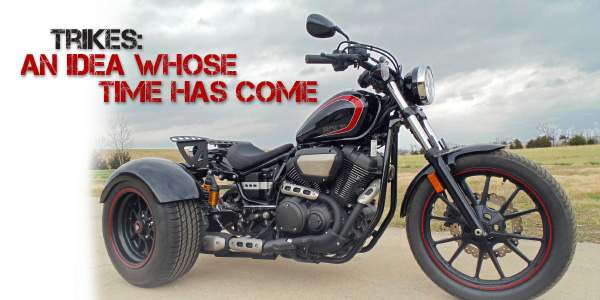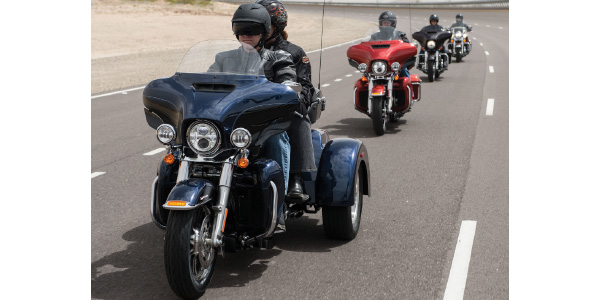
The three-wheeled motorcycle concept came out two years before Karl Benz was credited with creating the automobile. However, they have more or less been relegated to a small niche market within the industry. But this dynamic could change as baby boomers are starting to hang up their helmets in bigger numbers. Maybe three-wheels is a way to double up on your customer base?
“We have been building trikes for over 23 years,” says Motor Trike Founder Jeff Vey. “We started building trikes because we thought it was a product that would evolve into the motorcycle market based on the demographics of our customers. Sidecars were the only alternative at that time and this was a better product.”
Since balancing a heavyweight motorcycle can be challenge as riders age and experience more health issues, many riders are leaving the sport instead of staying in the saddle. Reflexes also change, but one thing that remains strong is the desire to ride, which is why Motor Trike has targeted the “Baby Boomer” generation.
Baby Boomers were the sons and daughters of the Silent Generation, born between 1946-1964. This is one of the most dynamic and powerful generations of our time with 76 million people being defined as “boomers.” This group of
Americans has typically been associated with the redefinition of cultural norms and the rejection of the status quo. This is partly why motorcycling was so appealing to them.
Another advantage that trikes have over traditional two-wheeled motorcycles is that a trike can be converted an existing bike. Trike conversion is a process that many shops offer as California Sidecar’s website explains: “Your bike is a part of you and trading your old friend in for a trike doesn’t feel right. Trike conversion is a way for you to keep your best riding buddy and still enjoy the open road with the same flair and passion as you had in the past.”
Frankenstein Trikes is another player in the trike conversion industry, and they say they’ve seen an increased demand for trike kits designed for smaller motorcycles in recent years. In response to this, Frankenstein Trikes has developed trike kits for the Harley-Davidson Street 500cc/750cc as well as the Yamaha Bolt 950cc.
Frankenstein offers a bolt-on trike kit that is built around a dependable billet aluminum and steel rear end with 9” Ford Street/Strip axles and a genuine Dana 30 differential. The kit includes the rear end, wheels, tires, fenders, fender brackets, swing arm, brake rotor, four-piston brake caliper, shocks (for Street), and connecting hardware. And the kit only adds 120 lbs. to the bike (H-D Street 500/750 and Yamaha Bolt). The company says installation is straightforward and can be completed in less than a day by an experienced technician. Luggage racks and trailer hitches designed to be used with Frankenstein’s trike kits are also available.

“The trike is the key to keeping people in the motorcycle market,” says Vey. “It sustains your customer base for another generation. If a motorcycle dealer in today’s market doesn’t have someone catering to the trike business, they are leaving money on someone else’s table.”
Vey thinks that the market for trike conversions has changed because the OEMs offer more options today. Can-Am has the Spyder, which is celebrating its 10th anniversary this year. Harley-Davidson has the Freewheeler that is marketed to older riders and women riders. Polaris is another OEM with skin in the game with its Slingshot, which is classified as an autocycle. Three-wheeled options are clearly on the minds of OEMs.
“There is a greater range of products being offered by the OEMs,” Vey explains. “Their ability to finance a turn-key trike and the size of their dealer network makes it easier for people to buy. The trade-off is the engineering, ride quality, and handling does not match the quality and performance of what our company provides. We have found the more people research the ‘Trike Project’ for their family, we win. If our dealers don’t have one on their floor, we lose on the ‘gotta have it now purchase.’”
The most popular bikes to convert are the touring models, and the Honda Gold Wing is the dominant model to convert for Motor Trike. “The touring market is 95% of our business,” says Vey. “The cruisers are our entry-level trike, and many of our customers trade up to a full touring bike within a couple of years.”
One of the things dealers who sell trike conversions should take into consideration is the learning curve that experienced riders need to get used to a three-wheeler. The dynamics are different and our experts recommend that dealers take the time to offer some training to customers.
“The longer they have ridden a two-wheeler, the longer it takes to get comfortable on a trike,” says Vey. “If they train and practice, it reduces the timeline by half. Dealers should spend some one-on-one time with the customer doing some simple drills in the parking lot to train them to steer through the turns and not lean through the turns to break old habits.”
Motor Trike, Frankenstein and others offer warranties and stand behind their conversion kits. They also offer good dealer margins for those who are interested in tapping into the three-wheeled market. For older riders who may have a few health issues but are perfectly capable riders, three wheels really are better than two!
SOURCES:
California Sidecar
www.californiasidecar.com
Frankenstein Trikes
www.frankensteintrikes.com
Motor Trike
www.motortrike.com













